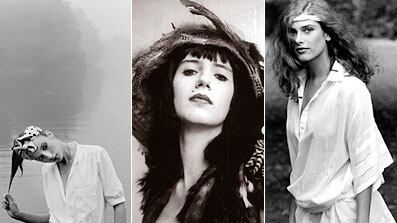What good is fashion photography and haute couture where there are no clothes worth buying and ostentatious luxury is a political faux pas? Twenty years after the fall of the Berlin Wall, an exhibit featuring the fashion of former Communist East Germany addresses this question. Free Within Borders, Photography, Fashion and Underground in the GDR, 1979-1989, now up in Berlin’s Museum of Applied Arts, is the first comprehensive show of its kind.
Click Image To View Our Gallery

The German Democratic Republic, which suffered shortages in everything from food to fabric, wasn’t exactly known for fashionable clothing. Ill-fitting, mass-produced synthetic government garb piled up and moldered in store windows, so undesirable that people preferred to sew their own attire using whatever fabrics they could get their hands on.
“At some point the government tried to pawn this excess of horrid clothing on the Soviet Union, where conditions were worse than in the GDR—but they didn’t want it either,” remembers Dorothea Melis, former editor of East Germany’s most esteemed fashion magazine Sibylle.
Eventually the communist government realized there was money to be made on high-quality fashion and opened a string of pricey boutiques. Although East Germans had few options for deposing of their money due to general shortages (purchasing a car, for example, took as long as 14 years), the so-called Exquisit shops were affordable only to some and generally appealed to an older clientele.
Left with few acceptable alternatives, most people cobbled together wardrobes from hand-me-downs, self-made items and handmade clothing sold at informal markets.
Magazine fashion spreads were not much different. Facing some of the same restrictions as the rest of the public, editors improvised using whatever looked right, often including clothing prototypes made by the government’s Fashion Institute but never mass-produced. Makeup artists got creative using “shoe cream in place of mascara when we couldn’t get ahold of the real thing, ” says Frank Schäfer, the GDR’s most sought-after stylist, who remembers experimenting with all sorts of makeshift products, often with surprising results (i.e. foot fungus creams that could be used to dye hair green or pink).
The end product was often stunning, as can be seen in the Berlin exhibition’s gorgeous black and white Sibylle prints. But at the time, the magazine “caused many a reader to fly into a rage” and write angry letters demanding to know where to find the clothing, according to Melis. “Our helpless answer was always ‘Improvise, sew things yourself, dig through old drawers and closets.’”
Nevertheless, magazines like Sibylle sold like hotcakes, and there were times that the popularity of the magazine combined with national paper shortages meant that they failed to meet reader demand. In a sense, fashion magazines always sell ideas and fantasy more than clothing—after all, who can afford the Escada get-ups in Vogue today? In East Germany, however, they also brightened a bleak quotidian reality and provided sample patterns that readers used to take fashion into their own hands.
“We knew what we didn’t want. We didn’t want to be trapped in a cage. And because we were trapped, we took every possible freedom.”
“The feeling captured in the photographs was by far more important than the clothing,” recalls Sibylle Bergemann, the legendary photographer and namesake of Sibylle, now a delicate 67-year-old with balletic poise. “We wanted to provide a sense of international, cosmopolitan style.”
The “feeling” offered, however, was state-monitored. Portraying strong but attractive females was the first rule in the GDR, where women and men were legal equals and 90 percent of women worked. It was important to dispense with “doll poses” and ladies of leisure who clearly lived on the expenses of their husbands.
Featuring strong women was a bottom line that editors and the state could agree on. But there were further restrictions imposed to bolster state ideology and interests. That meant no pets or cars—signs of extravagance; no photos, including butter and meat when there happened to be shortages in these areas; and certainly no images that had to do with East German repression.
Grit Seymour, one of the exhibition curators who worked as a model and designer in the GDR, recalls having to reshoot one Sibylle cover. “It showed me standing behind a barrier, which of course could be misconstrued as my being trapped behind the Wall.”
Skirting these restrictions was part of the fun for photographers and Bergemann notes that they joked about the rules and often got away with breaking them. Near the fall of the GDR, photos became increasingly risqué and daring, even showing lingerie and bathing attire.
Meanwhile, on the fringes of the official fashion world, a thriving underground scene pushed the boundaries much further. Within the context of a repressive society where individuals were regularly harassed by police and even arrested simply for having unusual style, young fashionistas—most all of them women—created extravagant avant-garde couture and staged hedonistic, often morbidly sexual fashion shows, heavily influenced by the aesthetics of punk, New Wave and Goth.
Photos and film footage from this scene, much of which has never before been exhibited, account for more than half of the current Berlin show. The one-off underground garments, often painstakingly crafted over a period of months, where made from whatever the designers could get their hands on, including hospital intestine bags and the black plastic farmers use to cover strawberries.
The underground’s most celebrated design group, Allerleirauh (All Kinds of Fur), made money by selling T-shirts crafted from bed sheets—one of the only reliable sources of high-grade cotton in the GDR. They then used this income to buy scraps of leather, fur and feathers, from which they sewed elaborate couture, often made up of tiny labor-intensive reptile-like scales.
Allerleirauh’s fashion shows were legendary, featuring models in flying-bird costumes, models attached two-a-piece by a single headdress, writhing birth scenes and general mayhem, all to the tune of specially composed music.
One of the group’s two designers, Angelika Kroker noted that for her models, who often created their own catwalk routines, these performances offered a rare chance for self-expression. “The costumes gave them the opportunity to be free,” she observed.
Garments, often painstakingly crafted over a period of months, were made from whatever the designers could get their hands on, including hospital intestine bags and the black plastic farmers use to cover strawberries.
"They pushed things very close to the edge and it felt very moving, very illuminating and freeing to be [at the shows],” recalls Grit Seymour. “It was an act of strong opposition cloaked in the guise of aesthetics and beauty."
“I’m not sure why we got away with it,” says Frieda von Wild, another of the show's curators, who was heavily involved in the underground scene. She proposed that perhaps the underground group enjoyed increased leniency hard-won by the GDR’s punk movement.
“We knew what we didn’t want,” added von Wild. “We didn’t want to be trapped in a cage. And because we were trapped, we took every possible freedom.”
After Germany’s reunification in 1989, a good number of East German designers, photographers and models continued on with professions in fashion. The underground scene and Allerleirauh, however, dissolved, as did Exquisit and Sibylle.
The opening of Free Within Borders last week was a lively and crowded reunion for those who had been involved with the tiny, tight-knit GDR fashion world. There were joyous gasps of surprise, reintroductions, and a collective marveling at the photographs and garb of a shared past. And most everyone still looked notably stylish.
“I don’t feel like it’s my job to show that the GDR wasn’t all colorless and gray,” remarked von Wild. “But if this show does that—well, good.”
Free Within Borders, Fashion, Photography and Underground, 1979-1989, will be showing in Berlin’s Kunstgewerbemuseum until September 9, 2009.
Caroline Winter is a Fulbright fellow and freelance journalist based in Berlin.






